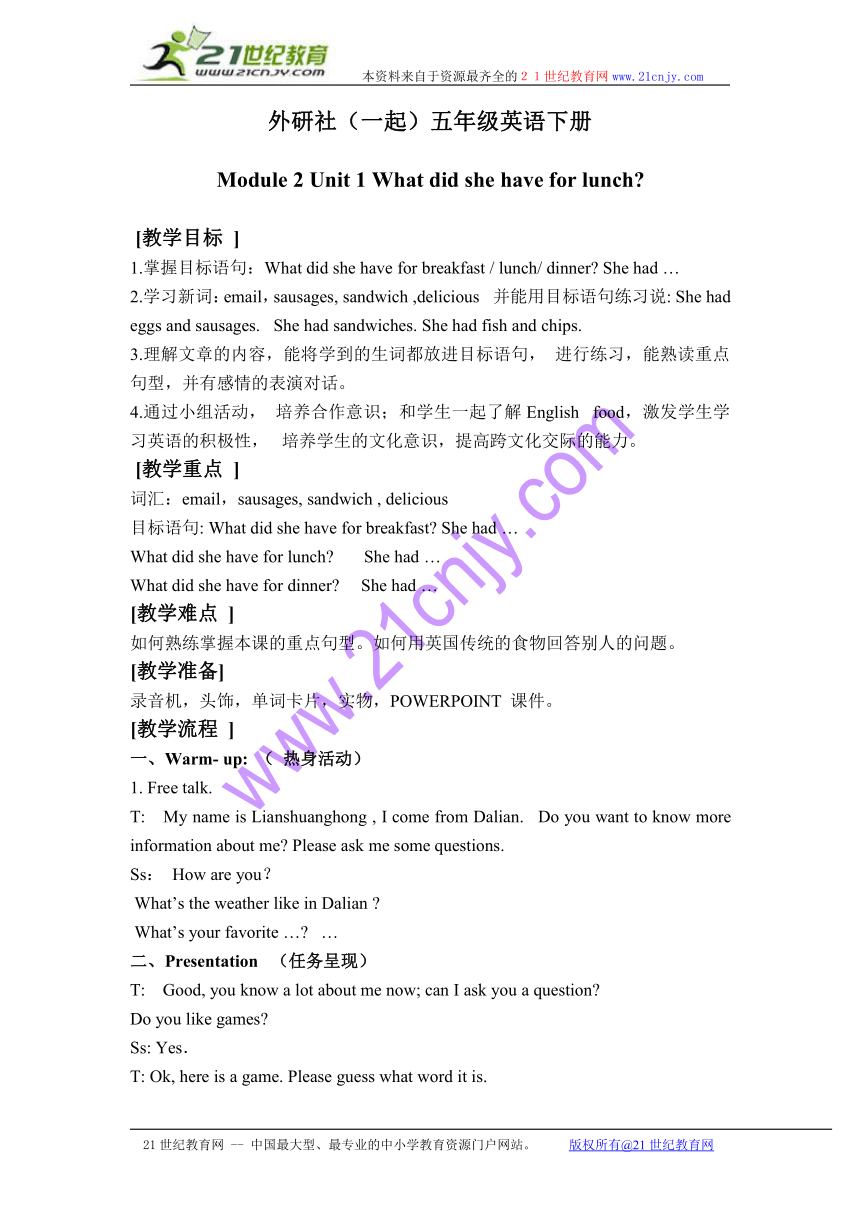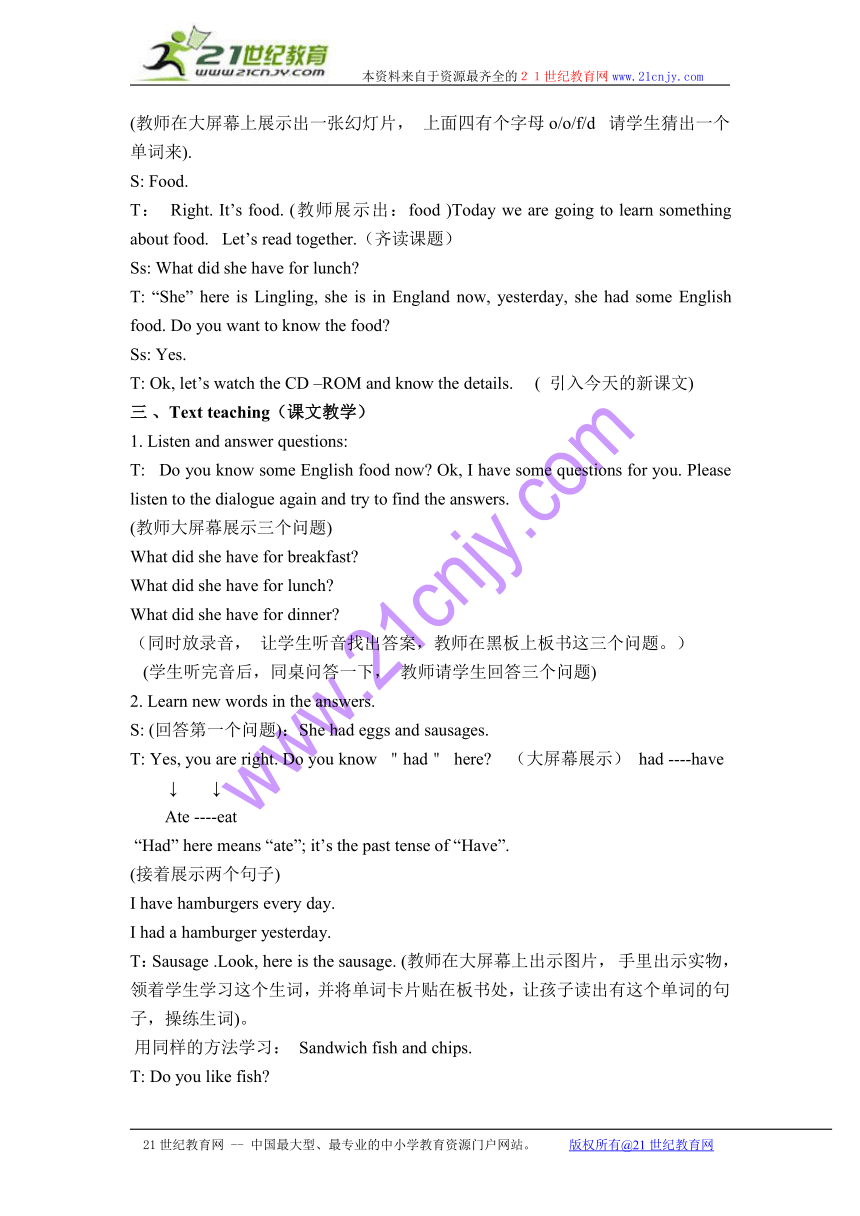外研版(一起)五年级英语下册教案 module 2 unit 1(1)
文档属性
| 名称 | 外研版(一起)五年级英语下册教案 module 2 unit 1(1) |  | |
| 格式 | rar | ||
| 文件大小 | 15.2KB | ||
| 资源类型 | 教案 | ||
| 版本资源 | 外研版(一年级起点) | ||
| 科目 | 英语 | ||
| 更新时间 | 2010-01-18 14:05:00 | ||
图片预览


文档简介
本资料来自于资源最齐全的21世纪教育网www.21cnjy.com
外研社(一起)五年级英语下册
Module 2 Unit 1 What did she have for lunch
[教学目标 ]
1.掌握目标语句:What did she have for breakfast / lunch/ dinner She had …
2.学习新词:email,sausages, sandwich ,delicious 并能用目标语句练习说: She had eggs and sausages. She had sandwiches. She had fish and chips.
3.理解文章的内容,能将学到的生词都放进目标语句, 进行练习,能熟读重点句型,并有感情的表演对话。
4.通过小组活动, 培养合作意识;和学生一起了解English food,激发学生学习英语的积极性, 培养学生的文化意识,提高跨文化交际的能力。
[教学重点 ]
词汇:email,sausages, sandwich , delicious
目标语句: What did she have for breakfast She had …
What did she have for lunch She had …
What did she have for dinner She had …
[教学难点 ]
如何熟练掌握本课的重点句型。如何用英国传统的食物回答别人的问题。
[教学准备]
录音机,头饰,单词卡片,实物,POWERPOINT 课件。
[教学流程 ]
一、Warm- up: ( 热身活动)
1. Free talk.
T: My name is Lianshuanghong , I come from Dalian. Do you want to know more information about me Please ask me some questions.
Ss: How are you?
What’s the weather like in Dalian
What’s your favorite … …
二、Presentation (任务呈现)
T: Good, you know a lot about me now; can I ask you a question
Do you like games
Ss: Yes.
T: Ok, here is a game. Please guess what word it is.
(教师在大屏幕上展示出一张幻灯片, 上面四有个字母o/o/f/d 请学生猜出一个单词来).
S: Food.
T: Right. It’s food. (教师展示出:food )Today we are going to learn something about food. Let’s read together.(齐读课题)
Ss: What did she have for lunch
T: “She” here is Lingling, she is in England now, yesterday, she had some English food. Do you want to know the food
Ss: Yes.
T: Ok, let’s watch the CD –ROM and know the details. ( 引入今天的新课文)
三 、Text teaching(课文教学)
1. Listen and answer questions:
T: Do you know some English food now Ok, I have some questions for you. Please listen to the dialogue again and try to find the answers.
(教师大屏幕展示三个问题)
What did she have for breakfast
What did she have for lunch
What did she have for dinner
(同时放录音, 让学生听音找出答案,教师在黑板上板书这三个问题。)
(学生听完音后,同桌问答一下, 教师请学生回答三个问题)
2. Learn new words in the answers.
S: (回答第一个问题):She had eggs and sausages.
T: Yes, you are right. Do you know "had" here (大屏幕展示) had ----have
↓ ↓
Ate ----eat
“Had” here means “ate”; it’s the past tense of “Have”.
(接着展示两个句子)
I have hamburgers every day.
I had a hamburger yesterday.
T:Sausage .Look, here is the sausage. (教师在大屏幕上出示图片, 手里出示实物,领着学生学习这个生词,并将单词卡片贴在板书处,让孩子读出有这个单词的句子,操练生词)。
用同样的方法学习: Sandwich fish and chips.
T: Do you like fish
S: No!
T: Fish is good for your health.
T:Are the food delicious
Ss: Yes.
(练习 delicious)
3. Practice the sentences.
(三个问题都回答完后, 生词基本解决, 让孩子小组练习, 教师提问小组问答)
4. looks and read.
(教师接着展示几句话, 这是书中的疑难点)
I’ve got an email from Lingling.
It’s about English food.
It’s a traditional English dinner.
She says it’s delicious, but it’s very different.
1)I’ve got an E-mail from Lingling.
( 解释E-mail then :Who can read the E-mail?教师将今天对话的内容做成一个email, 让学生duemail, 在email 中再次强化生词email,sausages, sandwich ,delicious, 并继续学习had 的用法)。
2) Its about English food.
通过英语说This book is about English.来解释about .
3) Its a traditional English dinner.
和学生一起来说一说traditional things, 例如: Jiaozi is traditional Chinese food, erhu is traditional Chinese instrument 等练习traditional.
4) She says it’s delicious, but it’s very different.
通过Snoopy和Mickey的比较说明different和same。
(此环节,教师的目标是处理书中一些重点的但又不是学习目标的句子和生词,为了让孩子更好的理解本课的对话,教师和孩子互动,举例子,还穿插了一些形成性评价,在课件的帮助下, 课堂气氛很活跃)。
四、Practice(巩固练习)
1. Listen and read. (学生听音读课文, 教师请全班分角色表演,检查一下对话的掌握情况)
2. Look and do.
做活动用书中的练习。孩子们根据所学课文, 看图根据问题选出答案。
接着请一个男孩子到前面来回答问题, 请大家一起对做题的男孩提问:
Who is the E-mail from 男孩子边回答 :It’s from Jingling , 便用鼠标点出答案。
What is the email about?
What did Lingling have for breakfast /lunch/dinner yesterday
(在这里每个学生都有任务。全班提问, 前面有人回答, 同时检查了答案, 一举三得)。
3. Guessing game.
大屏幕展示图片,What did she have for…
请学生猜:
She had…
She didn’t have …
She had…
很多孩子猜完后, 教师给出正确答案,大家读出 She had…
教师为回答正确的孩子发奖品, 这个活动继续操练重点单词和句型, 学生参与面很广,积极性高, 效果很好。
五、Task-fulfilling (任务完成)。
Do a survey.
教师先和学生做个示范, 请学生提问, 教师自己回答,然后让学生模仿做调查。 .
T:Please ask your friends:
What did you have for breakfast/lunch/dinner yesterday
Go around the class and ask anybody you meet.
(请学生到教室里寻找合作伙伴完成问答,接着做汇报。)
Ss: …had …for breakfast, had …for lunch, had …for dinner.
Name breakfast lunch dinner
Sam eggs Sandwich chips
六、Summary and homework .(小结与作业)
1. Ask children to read the words and sentences again, do the summary of the lesson.(和学生一起读板书上的单词和句子,再次巩固单词和目标语句。)
T: We know these words from the…
Ss: Email.
T: The food are very…
Ss: Delicious
T: Good.
(一问一答, 巩固单词)
2. Homework :
T:Today we learn some English food together, please finish your survey after class and tell some English food to your friends !
评析: 本节课的话题是English food, 教师围绕这个话题设计了很有效的教学活动,既有任务驱动下的主动参与,又有语言知识的实际运用, 既体现以任务为中心的任务型教学的原则,又体现了以活动为中心的课堂教学实践,是一节十分成功的高效的英语课。
纵观本课,教师从开始的语言导入,就很吸引学生, 她以一个小字谜游戏, 引出food,然后下面的所有活动都以 food 为中心,体现了今天的教学主题, 然后教师有充分的任务引导, 如听音回答问题,小组练习, 猜谜游戏,做个调查等,一个个任务层次分明,从不同的角度去练习孩子的语言知识,同时又都是为一个话题功能服务,学生一直在不同的活动中操练今天的语言,成功地完成了教学目标。
另外本课教师注重了语言背景的强化。 教师为学生播放CD-ROM ,使学生了解了今天的语言背景是在英国,玲玲给大明寄来了电子邮件的讲述了英国食物,然后用回答问题的方式,猜谜的游戏和做小调查的活动来操练语言,让学生明白本课的句型在生活中该如何运用,突出了语言学习的真实性和交际性,学生们在真实的语境引领中,轻松地学习了目标语句。
另外本课教师准备了一些小的食物作为对学生的奖励,这种评价方式既体现了本课的主题FOOD,也吸引了孩子的注意力,可谓一举两得。
总之, 这堂课以课程理念为指导,充分体现了以学生为中心,以任务为中心,以活动为中心的教学原则,环节清晰,衔接流畅,教学重难点突出,在丰富多彩的活动中充分锻炼了学生综合语言的运用能力!
21世纪教育网 -- 中国最大型、最专业的中小学教育资源门户网站。 版权所有@21世纪教育网
外研社(一起)五年级英语下册
Module 2 Unit 1 What did she have for lunch
[教学目标 ]
1.掌握目标语句:What did she have for breakfast / lunch/ dinner She had …
2.学习新词:email,sausages, sandwich ,delicious 并能用目标语句练习说: She had eggs and sausages. She had sandwiches. She had fish and chips.
3.理解文章的内容,能将学到的生词都放进目标语句, 进行练习,能熟读重点句型,并有感情的表演对话。
4.通过小组活动, 培养合作意识;和学生一起了解English food,激发学生学习英语的积极性, 培养学生的文化意识,提高跨文化交际的能力。
[教学重点 ]
词汇:email,sausages, sandwich , delicious
目标语句: What did she have for breakfast She had …
What did she have for lunch She had …
What did she have for dinner She had …
[教学难点 ]
如何熟练掌握本课的重点句型。如何用英国传统的食物回答别人的问题。
[教学准备]
录音机,头饰,单词卡片,实物,POWERPOINT 课件。
[教学流程 ]
一、Warm- up: ( 热身活动)
1. Free talk.
T: My name is Lianshuanghong , I come from Dalian. Do you want to know more information about me Please ask me some questions.
Ss: How are you?
What’s the weather like in Dalian
What’s your favorite … …
二、Presentation (任务呈现)
T: Good, you know a lot about me now; can I ask you a question
Do you like games
Ss: Yes.
T: Ok, here is a game. Please guess what word it is.
(教师在大屏幕上展示出一张幻灯片, 上面四有个字母o/o/f/d 请学生猜出一个单词来).
S: Food.
T: Right. It’s food. (教师展示出:food )Today we are going to learn something about food. Let’s read together.(齐读课题)
Ss: What did she have for lunch
T: “She” here is Lingling, she is in England now, yesterday, she had some English food. Do you want to know the food
Ss: Yes.
T: Ok, let’s watch the CD –ROM and know the details. ( 引入今天的新课文)
三 、Text teaching(课文教学)
1. Listen and answer questions:
T: Do you know some English food now Ok, I have some questions for you. Please listen to the dialogue again and try to find the answers.
(教师大屏幕展示三个问题)
What did she have for breakfast
What did she have for lunch
What did she have for dinner
(同时放录音, 让学生听音找出答案,教师在黑板上板书这三个问题。)
(学生听完音后,同桌问答一下, 教师请学生回答三个问题)
2. Learn new words in the answers.
S: (回答第一个问题):She had eggs and sausages.
T: Yes, you are right. Do you know "had" here (大屏幕展示) had ----have
↓ ↓
Ate ----eat
“Had” here means “ate”; it’s the past tense of “Have”.
(接着展示两个句子)
I have hamburgers every day.
I had a hamburger yesterday.
T:Sausage .Look, here is the sausage. (教师在大屏幕上出示图片, 手里出示实物,领着学生学习这个生词,并将单词卡片贴在板书处,让孩子读出有这个单词的句子,操练生词)。
用同样的方法学习: Sandwich fish and chips.
T: Do you like fish
S: No!
T: Fish is good for your health.
T:Are the food delicious
Ss: Yes.
(练习 delicious)
3. Practice the sentences.
(三个问题都回答完后, 生词基本解决, 让孩子小组练习, 教师提问小组问答)
4. looks and read.
(教师接着展示几句话, 这是书中的疑难点)
I’ve got an email from Lingling.
It’s about English food.
It’s a traditional English dinner.
She says it’s delicious, but it’s very different.
1)I’ve got an E-mail from Lingling.
( 解释E-mail then :Who can read the E-mail?教师将今天对话的内容做成一个email, 让学生duemail, 在email 中再次强化生词email,sausages, sandwich ,delicious, 并继续学习had 的用法)。
2) Its about English food.
通过英语说This book is about English.来解释about .
3) Its a traditional English dinner.
和学生一起来说一说traditional things, 例如: Jiaozi is traditional Chinese food, erhu is traditional Chinese instrument 等练习traditional.
4) She says it’s delicious, but it’s very different.
通过Snoopy和Mickey的比较说明different和same。
(此环节,教师的目标是处理书中一些重点的但又不是学习目标的句子和生词,为了让孩子更好的理解本课的对话,教师和孩子互动,举例子,还穿插了一些形成性评价,在课件的帮助下, 课堂气氛很活跃)。
四、Practice(巩固练习)
1. Listen and read. (学生听音读课文, 教师请全班分角色表演,检查一下对话的掌握情况)
2. Look and do.
做活动用书中的练习。孩子们根据所学课文, 看图根据问题选出答案。
接着请一个男孩子到前面来回答问题, 请大家一起对做题的男孩提问:
Who is the E-mail from 男孩子边回答 :It’s from Jingling , 便用鼠标点出答案。
What is the email about?
What did Lingling have for breakfast /lunch/dinner yesterday
(在这里每个学生都有任务。全班提问, 前面有人回答, 同时检查了答案, 一举三得)。
3. Guessing game.
大屏幕展示图片,What did she have for…
请学生猜:
She had…
She didn’t have …
She had…
很多孩子猜完后, 教师给出正确答案,大家读出 She had…
教师为回答正确的孩子发奖品, 这个活动继续操练重点单词和句型, 学生参与面很广,积极性高, 效果很好。
五、Task-fulfilling (任务完成)。
Do a survey.
教师先和学生做个示范, 请学生提问, 教师自己回答,然后让学生模仿做调查。 .
T:Please ask your friends:
What did you have for breakfast/lunch/dinner yesterday
Go around the class and ask anybody you meet.
(请学生到教室里寻找合作伙伴完成问答,接着做汇报。)
Ss: …had …for breakfast, had …for lunch, had …for dinner.
Name breakfast lunch dinner
Sam eggs Sandwich chips
六、Summary and homework .(小结与作业)
1. Ask children to read the words and sentences again, do the summary of the lesson.(和学生一起读板书上的单词和句子,再次巩固单词和目标语句。)
T: We know these words from the…
Ss: Email.
T: The food are very…
Ss: Delicious
T: Good.
(一问一答, 巩固单词)
2. Homework :
T:Today we learn some English food together, please finish your survey after class and tell some English food to your friends !
评析: 本节课的话题是English food, 教师围绕这个话题设计了很有效的教学活动,既有任务驱动下的主动参与,又有语言知识的实际运用, 既体现以任务为中心的任务型教学的原则,又体现了以活动为中心的课堂教学实践,是一节十分成功的高效的英语课。
纵观本课,教师从开始的语言导入,就很吸引学生, 她以一个小字谜游戏, 引出food,然后下面的所有活动都以 food 为中心,体现了今天的教学主题, 然后教师有充分的任务引导, 如听音回答问题,小组练习, 猜谜游戏,做个调查等,一个个任务层次分明,从不同的角度去练习孩子的语言知识,同时又都是为一个话题功能服务,学生一直在不同的活动中操练今天的语言,成功地完成了教学目标。
另外本课教师注重了语言背景的强化。 教师为学生播放CD-ROM ,使学生了解了今天的语言背景是在英国,玲玲给大明寄来了电子邮件的讲述了英国食物,然后用回答问题的方式,猜谜的游戏和做小调查的活动来操练语言,让学生明白本课的句型在生活中该如何运用,突出了语言学习的真实性和交际性,学生们在真实的语境引领中,轻松地学习了目标语句。
另外本课教师准备了一些小的食物作为对学生的奖励,这种评价方式既体现了本课的主题FOOD,也吸引了孩子的注意力,可谓一举两得。
总之, 这堂课以课程理念为指导,充分体现了以学生为中心,以任务为中心,以活动为中心的教学原则,环节清晰,衔接流畅,教学重难点突出,在丰富多彩的活动中充分锻炼了学生综合语言的运用能力!
21世纪教育网 -- 中国最大型、最专业的中小学教育资源门户网站。 版权所有@21世纪教育网
同课章节目录
- Module 1
- Unit 1 She was a driver before.
- Unit 2 He worked in an office .
- Module 2
- Unit 1 What did she have for lunch?
- Unit 2 Lunch is usually at half past twelve.
- Module 3
- Unit 1 Have you got the Harry Potter DVDs?
- Unit 2 You can use the computers.
- Module 4
- Unit 1 Did you read them?
- Unit 2 My favourite season is spring.
- Module 5
- Unit 1 Your bag is broken.
- Unit 2 Mine is pink.
- Module 6
- Unit 1 We' ll see lots of very big stones.
- Unit 2 It was amazing.
- Module 7
- Unit 1 My father goes to work at 8 o'clock every m
- Unit 2 I'll be home at 7 o’clock.
- Module 8
- Unit 1 Will you help me ?
- Unit 2 I made a kite.
- Module 9
- Unit 1 We laughed a lot.
- Unit 2 Mum bought new chopsticks for you.
- Module 10
- Unit 1 What did you put in your bag ?
- Unit 2 I played on the beach.
- Review Module
- Unit 1
- Unit 2
